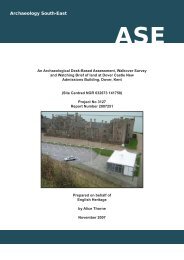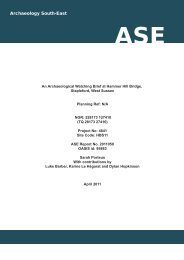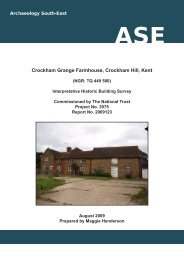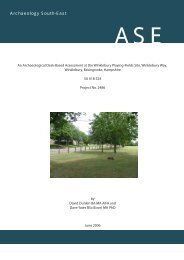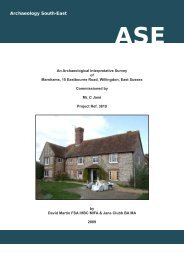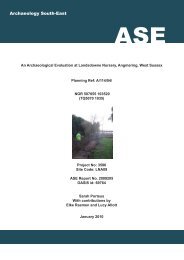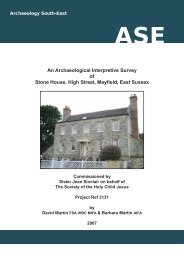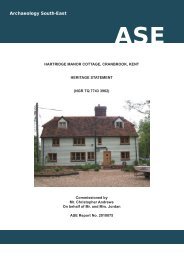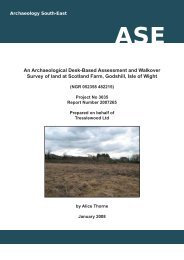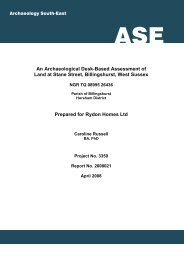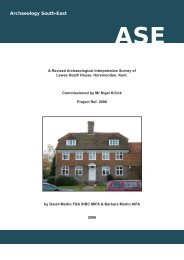ASE front cover - Archaeology South-East
ASE front cover - Archaeology South-East
ASE front cover - Archaeology South-East
You also want an ePaper? Increase the reach of your titles
YUMPU automatically turns print PDFs into web optimized ePapers that Google loves.
<strong>Archaeology</strong> <strong>South</strong>-<strong>East</strong>2008058: Holbury Infants School, Holbury, Hampshirethe material slumped on both sides of the pit, [1066] and [1070], are thesame context but this cannot be definitively concluded making interpretationcomplex. Further, the artefacts re<strong>cover</strong>ed from the pit provide a similar daterange for all contexts, not facilitating the interpretation of the stratigraphicrelationships between the fills.4.6.5 Fill [1066] was a mid orangey brown silty clay containing pottery, CBM, firecracked flint, stone, metal and burnt clay. Fill [1065] was a light orangeybrown silty clay with occasional small gravel inclusions, 4-8mm in size,which produced pottery of AD 270 to early/mid 4 th century date. Fill [1064]was a dark grey clay. Fill [1070] was an orangey brown silty clay, withlenses of redeposited natural containing pottery dated to AD 270 toearly/mid 4 th century. Fill [1069] was a greyish brown silty clay withoccasional small pebbles and gravel containing one bodysherd of pottery.Fill [1072] was a grey clay with very occasional gravel inclusions, 1-2mm insize, which produced bodysherds of pottery dating from AD 270 to theearly/mid 4 th century. Fill [1068] was a greyish brown with orangey mottlessilty clay with occasional small pebbles and gravel inclusions. Fill [1040]was a light orangey brown silty clay with occasional small pebble and gravelinclusions. Fill [1039] was a greyish brown clay with very occasional gravelinclusions. Fill [1005] was a light orangey brown silty clay with occasionalflecks of charcoal. Pottery dated to AD 300-360 was re<strong>cover</strong>ed from [1005]including a New Forest beaker sherd with white painted decoration, morecommon around AD 340-360 along with Roman tegula, burnt flint and apossible fragment of quern stone. Fill [1063] was a light greyish brown silyclay with occasional gravel inclusions, 5-10mm in size. Fill [1062] was agrey gravel with frequent gravel inclusions, 10-60mm in size. Fill [1071] wasa greyish brown silty clay with occasional gravel inclusions 5-10mm in size.Fill [1038] was a light orangey brown silty clay with occasional small gravelinclusions which contained one sherd of pottery dated to AD 50-250, mostprobably to the latter end of this range. Fill [1038] contained a lense oflightly burnt material [1015] identified in plan at the surface of the pit but notvisible (or recorded) in section; it was a greyish black gravely silt withoccasional flecks of charcoal, producing pottery dated from AD 270 to theearly/mid 4 th century and Roman brick and tile. Fill [1037] was a greyishbrown silty clay with occasional small gravel inclusions, 2-6mm in size,which contained pottery. Fill [1042] was a mid grey silty clay. Potterybodysherds of AD 270 to early/mid 4 th century date, Roman brick and tegulawere re<strong>cover</strong>ed from [1042] along with fragments of burnt clay with a flatsurface including a piece of possible flooring, three fragments of rotaryquern stone and a medium grain sandstone whetstone. Fill [1067] was amid greyish brown clay with occasional gravel inclusions 10-20mm in size.Fill [1061] was a mid brown with orange mottles silty clay with occasionalgravel inclusions. Fill [1033] was a light orangey brown silty clay withoccasional flecks of charcoal. Fill [1034] was a light yellowish brown siltysand with frequent gravel inclusions 5-30mm in size. Fill [1060] was a darkgreyish brown silty clay with frequent gravel inclusions 10-60mm in size. Fill[1036] was a very dark brown silty clay with moderate gravel inclusions 10-40mm in size and flecks of burnt clay, which produced pottery dated fromAD 270 to early/mid 4 th century, Roman tegula and imbrex and metal. Fill[1035] was a dark brown silty clay with moderate gravel inclusions 10-30mmin size, which contained pottery dated from AD 270 to early/mid 4 th century,Roman brick and tegula, metal and a fragment of rotary quern stone. Fill[1006] was a mid brown silty clay with moderate gravel inclusions 10-40mm14© <strong>Archaeology</strong> <strong>South</strong>-<strong>East</strong>



